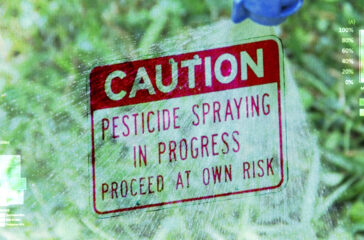CDC finds weed killer tied to cancer in over 80 pct of US urine samples
In fresh evidence of the pervasive nature of pesticides, more than 80 percent of urine samples drawn from children and adults participating in a US health study contained a weedkilling chemical linked to cancer and other health problems.
The June 30 report by a unit of the Centers for Disease Control and Prevention (CDC) found that out of 2,310 urine samples collected, 1,885 were laced with detectable traces of glyphosate, the active ingredient in herbicides sold around the world, including the widely used Roundup brand.

New evidence of pesticide links to cancer
Building on years of research that shows links between agricultural chemicals and cancer, researchers say they have found fresh evidence tying certain pesticides to cancers in children and adults in 11 western U.S. states.
Analyzing federal pesticide data and state health registries, the research team reported a close association between the use of pesticides called fumigants and the development of cancers in people living in the states analyzed.
The study, published last month in the journal GeoHealth, is the first to analyze the geospatial distribution of cancer incidence with pesticide use in the Western United States. The authors are three researchers from the Idaho Water Resources Research Institute at the University of Idaho and three researchers from Northern Arizona University.

Crypto mining, controversy, and questions about environmental impacts
For decades, the Mechanicville hydroelectric plant generated power from New York’s Hudson River, converting the flowing waters into energy that fueled General Electric. But last year, the long brick building became the home of a crypto mining operation, forging a very different role as part of a vast network of sites around the world pumping out algorithms that make virtual currency viable.
Opened in 1898, the antiquated hydroelectric plant was an unlikely candidate to combine with the modern technology that is the cryptocurrency industry. And after less than a year in operation, the crypto mining work there has been halted amid turmoil and controversy roiling the cryptocurrency market and higher prices for electricity.

Guest column: The Roundup reckoning: Farmworkers win key glyphosate decision
Earlier this month, a court decision about a chemical called glyphosate garnered headlines in newspapers across the country. And rightly so: glyphosate is the active ingredient in Monsanto’s Roundup weedkiller. The pesticide is sprayed on roughly 285 million U.S. acres, and is so popular globally that it is the world’s most widely used herbicide.
For decades, Monsanto and the U.S. Environmental Protection Agency (EPA) have assured us that glyphosate herbicides are safe. But those assurances have increasingly come under challenge by evolving science.

Supreme Court again rejects Bayer bid for review of Roundup loss
The US Supreme Court on Monday dealt another blow to Bayer AG’s effort to defend itself against ongoing litigation over allegations that Roundup herbicide causes cancer, denying the company’s request for a review of a California trial loss.
In declining to take up the case, the court let stand an $87 million award won by Alva and Alberta Pilliod. The jury originally ordered more than $2 billion in damages for the married couple, but the award was later cut by the court. Each of the Pilliods alleged they developed non-Hodgkin lymphoma after extensive use of Monsanto’s Roundup products.

As wildfires take over the West, Oregon winemakers adapt
By Lena Beck
It was almost two years ago – the morning of September 8, 2020 – when Clea Arthur started her day with a five-mile run along the Pacific Crest Trail where it crosses Mount Ashland in southern Oregon.
“It was beautiful,” Arthur said. “I had the most beautiful run, until the whole world fell apart.”
Though Arthur had no inkling of the devastation that was to unfold, that September morning became marked in history as the day that a raging wildfire burned through 3,000 acres and destroyed more than 2,500 homes in the valley at the foot of the mountain where Arthur was running. Dubbed the Almeda Fire, it became known as one of the most destructive in Oregon history.
Among the scores of businesses damaged in the fire was a winery and tasting room that Arthur had opened with her partner Brian Denner in 2017. Following the fire all that remained of their operation was a mix of melted steel and the concrete foundation of what had been their business. All their wine was lost — equivalent to more than 34,000 bottles.

As farmers struggle with PFAS ‘forever chemicals,’ Maine races for solutions
For the past 18 years, Maine farmer Bill Pluecker has worked long hours tending to his family’s organic vegetable farm, growing crops he sells directly to consumers through a community agricultural program.
Working on the farm is a job that Pluecker juggles with his elected position as a state lawmaker, and the combination of roles gives Pluecker particular insight into a devastatingly broad environmental contamination problem farmers are facing throughout Maine, and around the United States.
The problem is PFAS. Often referred to as “forever chemicals” because they do not break down and can persist indefinitely, per- and polyfluoroalkyl substances (PFAS) have become recognized as a significant health and environmental threat with long tenacles. Researchers have found PFAS contaminating water, soil, food, and even the bodies of humans and animals around the world.
Widely used in consumer goods and industry since the 1940s, PFAS include more than 9,000 synthetic chemicals that build up in living tissue and can endanger health.
“It’s overwhelming; it’s in our products, in our bodies, in our food system,” said Pluecker, who is grateful that his own farm appears not to be contaminated with the PFAS he calls “poison.”

In South Carolina, residents battle paper mill pollution and say EPA falling short
A group of residents who say they are “prisoners” in their homes because of ongoing pollution from a South Carolina paper mill will have their complaints aired in federal court on Wednesday as the mill seeks to dismiss their class action lawsuit.
Two North Carolina and eight South Carolina residents, all living within a range of 2-1/2 to roughly 14 miles from the paper mill, are the named plaintiffs in the lawsuit. They blame the mill for alleged “egregious and wrongful emission of foul and harmful hydrogen sulfide, methyl mercaptan, methanol, and other pollutants and contaminants to the air,” along with discharging “inadequately treated wastewater” into the Catawba River.
They are asking the court to stop the plant from continuing to release the pollutants. The complaint includes data and reports showing that state regulators and federal regulators ordered the plant to clean up its operations more than a year ago. The finalization of a consent decree is still pending, however.
The pollution stemming from operations at New-Indy Catawba LLC in Catawba, South Carolina affects potentially more than one million people who live and work in the region, according to the complaint, filed in the U.S. District Court of South Carolina.

Farm groups ramp up battle to keep using banned pesticide to grow food
By Anthony Lacey and Carey Gillam
A powerful contingent of agricultural and produce grower groups this week filed the latest salvo in a years-long battle over the pesticide chlorpyrifos, seeking to reverse a new rule banning the chemical from use in U.S. food production.

Guest column: Fragmented FDA leadership contributed to formula failure
By Scott Faber
America’s infant formula shortage has raised urgent questions about the safety of our food supply. Most Americans believe America has the safest food supply in the world. But, the tragic failure to address contaminated infant formula as well as a hard-hitting investigation about the failures at FDA’s food safety division has revealed dangerous holes in our food safety net.
 EWG
EWG